22
Oct

Electrical enclosures serve to protect and accommodate electronics and electrical components from any kind of unwanted accidental occurrence or simply, the environment. There is a vast array of different types of enclosures to choose from, however, few factors should be considered. For example, do you need electrical enclosures for industrial, commercial or residential application. This article will help guide you in the selection process to find the right enclosure for your application. Here’s what you will need to consider.
The environment in which you should leave the enclosure and the piece of equipment that requires protection, are some of the most essential things to be considered. Rain, wind and the temperature can largely account to the longevity of the electrical enclosures. There are enclosures built to protect against salt spray, heavy rain, blowing wind and more. The devices in the enclosures must be well protected, therefore the material needs to be strong, durable and long lasting.
Stainless steel electrical enclosures are without a doubt the best choice you can make, if loosing your electrical equipment is not on your to-do-list. These enclosures are especially suitable if you need protection from chlorine and salt. Other types of material you can choose from are Polycarbonate and Fiberglass. The are much easier to modify, when compared to the ones made from stainless steel, so if high strength (weight ratio wise) and the ability for modification of what you need, these enclosures might suit you more.
The size of the electrical enclosure must fit the application properly. Have the dimension of the length, width and height ready when looking for the enclosure for the component you want to protect. Furthermore, choose the size also according to heat dissipation and get controls over the enclosure’s cover if you think that your situation requires such precaution. Always double check external dimension if the enclosure fits into an already existing footprint.
Thermal management is another important thing you must consider, since natural cooling or heating simply won’t do in most cases. Without getting proper thermal management, your devices won’t get the protection needed and you’ll be risking permanent damage.
The mounting surface should be able to completely hold the weight of the electrical enclosure. All of the planned modifications should be previously discussed and tested. Finally, once you are done with all of the precaution measurements and essential requirements, you can even choose to accessories the enclosure.